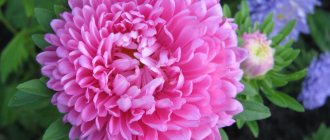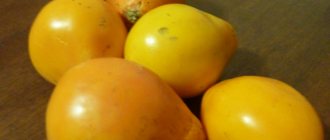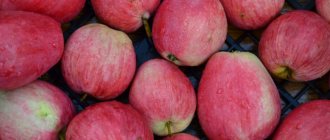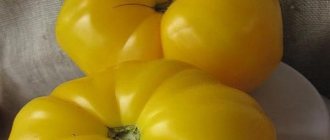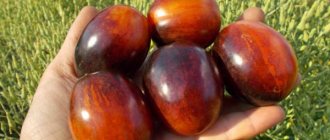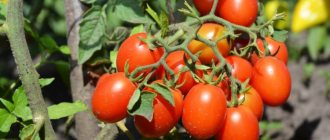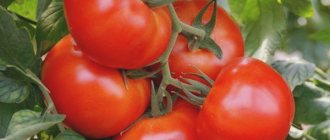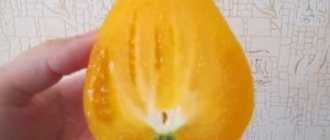Cherry tomatoes have been grown by Russian vegetable growers relatively recently. However, summer residents have already developed their favorite varieties and hybrids of these small tomatoes, which may differ in the shape and color of the fruit, but have some similar characteristics.
But among the variety of varieties and hybrids of such tomatoes, it is not always possible to make a choice - which tomato to plant on your plot. Those who would like to grow an unpretentious, hardy, productive and tasty cherry tomato variety in their garden should turn their attention to the Summer Sun tomato.
Description of the variety Summer Sun
This tomato variety is classified as an indeterminate type, so its shoots are not limited in growth. The central shoot can grow up to 1.8-1.9 m and higher, while remaining strong and powerful. Many vegetable growers pinch the top of the central shoot to limit its growth and encourage the growth of side shoots.
We also recommend the Family tomato variety
This tomato variety actively produces shoots that need to be removed regularly so that their growth does not interfere with the ripening of small fruits.
This tomato is distinguished by the average ripening period of tomatoes - from the moment of germination of the seed material to the harvesting of the first ripe fruits, about 4 months pass.
The shoots are medium leafy. Their foliage is oval, slightly wrinkled, with slightly elongated sharp tips. Rare notches are clearly visible along the edges. The color of the leaf blades is rich emerald. For better yield, it is recommended to grow these bushes in 2-3 shoots. To do this, leave a couple of stepsons formed above the first flower brush, and the remaining stepsons located below and above must be removed. And from those left behind, side shoots will grow, on which ovaries will form after fruiting on the central stem ends.
Related article:
Fertilizers for tomatoes
The flowers are small in size, with yellow petals. They are collected in racemose inflorescences, the first of which can be formed under 6 or 7 true leaves. In total, up to 16-17 brushes with ovaries may appear on the bush. And in each inflorescence up to 8 cherry fruits can appear.
The shape of ripe small fruits is oval, slightly oblong, with a diameter of 3 cm and a weight of about 30 g. The skin of these tomatoes is smooth, even, compacted, glossy, and not prone to cracking. Its color at the stage of technical maturity is amber-golden, rich.
The pulp of these fruits is quite fleshy, with a small amount of liquid. Each tomato can have about 6 seed chambers, which contain few seeds.
Since the Summer Sun tomato is a variety and not a hybrid, seed material can be collected from its fruits for subsequent planting. However, you need to remember that seeds collected from the garden will become less germinating over time, and the characteristics of the tomatoes grown from them will deteriorate. Therefore, it is recommended to purchase new planting material from gardening stores every 4-5 seasons.
The yellow color of these ripe cherry tomatoes indicates that they contain carotene, antioxidants and lycopene. And their taste is very pleasant - sweetish with a slight sourness. It also contains fruity notes.
The harvested crop can be transported to different distances, and these small fruits also have a fairly long shelf life under appropriate conditions.
Related article:
So that there are more tomatoes than greens on them
Main characteristics of the variety
This tomato variety is resistant to sudden changes in temperature. In addition, it is unpretentious and does not require special care.
Productivity
For a tomato from the cherry series, the Summer Sun tomato has a good yield - from each bush you can collect up to 3 kg of ripe, bright small fruits. And from each square of area up to 7 kg is usually collected.
Area of application of fruits
The Summer Sun cherry variety has a pleasant, delicate taste with a small amount of acid, and contains a large amount of useful substances. Therefore, doctors recommend using the fruits of the Summer Sun tomato in dietary nutrition, and also giving it to children.
These small, colorful fruits are so sweet that children happily eat them straight from the bush.
Also, if desired, you can seal them whole in jars; their skin does not burst during heat treatment, so they look very beautiful and appetizing in jars. And their taste acquires a pleasant tartness and pungency.
Proper care of tomatoes
Summer Sun cherry tomatoes are finicky plants. In order to grow healthy fruits and get a high-quality harvest, you should follow some recommendations for caring for tomatoes. The following rules are distinguished:
Tomatoes require mandatory watering; they absolutely cannot tolerate drought.
It is important to ensure daily moderate irrigation of the soil, but so that the soil is not flooded. Watering should be carried out only in the first half of the day and preferably before the first rays of the sun appear.
The introduction of nutritious moisture should be done only at the root, without affecting the tender leaves of the plant. Otherwise, the remaining moisture on the tops and the sun's rays will cause burns. The greatest amount of watering is required at the moment when the plant begins to form inflorescences and fruits. The soil should be loosened periodically, while eliminating weeds that have managed to grow. You should not provoke high air humidity - 50-60% humidity is an unfavorable condition for growth for a plant, provoking the development of pathogenic bacteria. If growing occurs in greenhouse conditions, then it is necessary to maintain a daytime temperature of +22..+24 C, and at night it is worth reducing the degrees to +16..+18 C. Due to the high growth of cherry tomatoes, it is recommended to constantly tie them up as they grow.
If you grow plants in a greenhouse, they will have a less pronounced taste than outdoors. Only full ripening brings Summer Sun fruits a full range of taste sensations. If you pick the fruits from the bush when they are not yet ripe, they will not have a specific aroma or unique taste.
By following simple rules for caring for tomatoes with amber-yellow Summer Sun fruits, the gardener gets an excellent harvest with excellent taste and dense inner pulp.
Flaws
But this tomato also has its drawbacks:
- tomato bushes are demanding on lighting, so they grow and bear fruit poorly even in light partial shade;
- The shoots of the Summer Sun tomato are too tall, with a fairly large number of ripening fruits, so they require mandatory garter as they grow.
Related article:
How to grow tomatoes in a greenhouse
Pests and methods for their elimination
Pests, as well as diseases, are frequent guests in tomato plantings. The following parasitic individuals are identified that like to settle on Summer Sun tomatoes:
- Wireworms - carry out their activity on the roots of plants and can go deep into the center of the tomato stem. This process leads to the complete death of the bush. To eliminate a large number of parasites, it is recommended to manually collect the detected worms during digging and then destroy them later. If tomatoes are planted on soil with an acidic pH environment, then liming should be carried out, which will reduce the population of parasitic animals.
- The mole cricket is a pest that digs deep holes in the ground, damaging the root system of the plant, which provokes the death of the entire shrub. To eliminate the parasite, the soil is treated with the chemical “Thunder”.
- Slugs - in most cases are localized on surfaces with high humidity. Pests have the peculiarity of eating the foliage of tomatoes and eating through fruits located at the base and near the ground.
- Colorado potato beetle - lays its eggs on the underside of the leaf surface. The eggs subsequently hatch into larvae that eat large parts of the tops of the bush. To control, you should collect pests yourself and neutralize them while monitoring and inspecting the plant. In addition, it is possible to use the chemical insecticide Prestige.
The main thing is that when harmful insects appear, the weakening of the plant is visible. If the bush begins to die, the cause should be sought, either on the foliage or in the roots. Thus, Summer Sun cherry tomatoes are capricious plants, but do not require special conditions for growing. To get a high-quality harvest, it is recommended to simply follow all the rules for caring for the plant.
More information can be found in the video:
Nuances of planting and growing
The Summer Sun tomato should only be grown using seedlings. To do this, you must first prepare the nutrient substrate and appropriate containers.
Preparing soil and containers
Soil for growing seedlings of this tomato can be purchased at a specialty store, but some vegetable growers prefer to prepare the nutrient substrate themselves. To do this, you need to mix equal parts of river sand, the top layer of peat, humus and wood ash. Also, such a soil mixture is spilled with a solution of mineral substances - superphosphate (25 g), potassium sulfate (30 g), urea (10 g) are dissolved in 10 liters of water.
Before laying out the nutrient substrate you prepared yourself, it should be disinfected. To do this, you need to spill it with a solution of potassium permanganate. Once the soil is dry, it is ready to use. Containers for planting seeds of this tomato should be sufficiently long and wide, but not high. Before placing soil in them, containers are also disinfected.
Planting seeds
The seed material of this tomato variety is planted approximately 55-60 days before the grown plants are transplanted to a permanent location. Based on this, the timing of their planting in specific Russian regions is calculated depending on climatic conditions.
The seeds are buried 1-1.5 cm into the soil, the soil is moistened with a spray bottle, covered with film for faster germination of the seed material and placed in a warm place. At this time, the room temperature should be maintained around +24+26 degrees Celsius.
After the sprouts appear, the film is removed and the plants are transferred to a bright place. As the seedlings grow, they are regularly watered, and at the stage of a couple of true leaves, the thickened plants are picked. 10-12 days after this procedure, you can feed the tomato seedlings for the first time - they will already have time to acclimatize after picking. To do this, use urea, nitroammofska or any other fertilizer that contains a sufficient amount of nitrogen. This feeding is repeated after a couple of weeks.
Related article:
Tomato Rio Grande - description and characteristics of a super-yielding variety
10-13 days before transplanting the grown seedlings to the beds, you need to carry out a hardening procedure - take the growing plants outside for half an hour, but over time, the time in the air for these seedlings needs to be increased.
Seedlings ready for transplanting must have at least 7 leaves and one flower cluster with unopened buds.
Choosing a place for planting seedlings
The area in which the Summer Sun tomato bushes will grow must be well lit, otherwise these plants will develop poorly. Organic matter and mineral fertilizers must be added to the soil for digging to improve fertility.
Transplanting seedlings
When planting plants, you need to dig planting holes at a distance of 0.5-0.6 m from each other. And on each square of area you need to plant no more than 3 bushes of this tomato.
Further care
In the future, it is necessary to regularly water the tomato bushes; the soil should be constantly moist, but without stagnant moisture. Watering is carried out in the evening or morning only under the roots, so that drops of water do not remain on the foliage and stems.
For each tomato you need to add 7 liters of water and water it every 2-3 days. In rainy weather, the amount of watering should be reduced.
After watering, the soil is loosened, all weeds are removed at least once a week, and then the root zone is mulched with straw or peat. The mulch layer should be no more than 5 cm.
During the season, you should feed the Summer Sun tomato bushes with organic fertilizers, bioinfusions or Agricola.
Related article:
Growing different varieties of tomatoes
You should also form bushes into 3 shoots to increase plant productivity.
As the shoots grow, they need to be tied to strong supports, and, if necessary, supports should be placed under the shoots at the time of active fruit ripening.
It is also important to collect ripening tomatoes in a timely manner, then new fruits will ripen faster.
Diseases and the fight against them
Like any other plant, cherry tomatoes become infected with various diseases. If planting is not controlled, pathogenic bacteria will develop on the seedlings. The following are the most common diseases:
- Late blight can affect most of the plant. A distinctive sign of the disease is the formation of brown spots, which are located under the upper skin of the foliage and fruits. A white, fuzzy coating forms on the underside of the affected tops. To eliminate an incipient disease, it is recommended to use a chemical antifungal fungicide.
- Cracking of fruits - a problem occurs when a large amount of liquid is supplied to the plant. To eliminate the disease, it is recommended to reduce the volume of introduced nutrient moisture and more often loosen the soil near the base of the tomato.
- Tomato mosaic - when diseased, the foliage of the plant completely changes its color. Spots of varying sizes of yellow or brown tones appear on the greenery. The foliage begins to wrinkle and curl. At the same time, the fruits are damaged - they can also acquire an abnormal dirty yellow or putrid hue. In addition to damage to the tops, the plant completely weakens. Any exposure to traditional methods or chemical fungicides does not help. To avoid infecting healthy shrubs, damaged plants are pulled out of the ground along with their roots and burned.
- Brown spot - occurs as brown spots on the underside of cherry tree foliage. These new growths are covered with a grayish coating on top. The most important and correct treatment is to remove all plant debris falling from the tomatoes from under the base.
To prevent the appearance of pathogenic bacteria, the condition of the tomatoes should be constantly monitored. When the first signs appear, quick elimination of a small infection does not generally affect the bulk of the plantings. If necessary, be sure to seek help from chemical insecticides. Do not wait until the disease infects the entire area of the seedlings.


